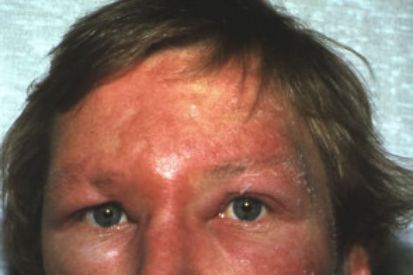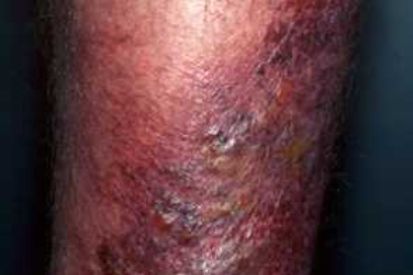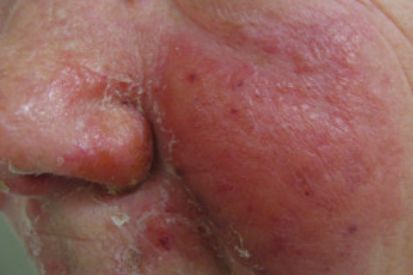Erysipelas
Erysipelas, a bacterial skin infection, is characterized by red, swollen, warm and/or painful patches on the skin's surface, often accompanied by fever and chills. It can also appear as lesions with raised borders that most frequently appear on the face or legs, or as sores on the cheeks and bridge of the nose. It is usually caused by the Streptococcus bacteria and occurs in both adults and children. This infection typically occurs when bacteria enter the skin through a break or crack.
Erysipelas requires prompt medical treatment. Our trusted Dermatology of Southeastern Ohio providers specialize in erysipelas management, offering advanced solutions to alleviate symptoms and prevent complications. If you suspect erysipelas, schedule an appointment at Dermatology of Southeastern Ohio for a thorough evaluation and tailored treatment plan to restore your skin health.
Examples of Erysipelas



What are the Symptoms of Erysipelas?
- Fiery red rash on the face and legs.
- Swelling and warmth in the affected area.
- Intense pain associated with the rash.
- Well-defined, raised border of the affected skin.
- Rapid progression of the rash.
- Fever and chills.
- Tenderness and a feeling of tightness in the affected skin.
Causes of Erysipelas
- Bacterium Streptococcus pyogenes, also known as group A Streptococcus. This bacterium enters the body through breaks or cracks in the skin, or skin conditions like eczema or dermatitis.
- Skin injuries, surgical wounds, or chronic skin conditions that compromise the skin's integrity.
- Poor circulation, often associated with conditions like diabetes or venous insufficiency.
- Lifestyle factors such as intravenous drug use, or obesity may further elevate the risk.
How to Prevent Erysipelas
If you notice any signs of skin infection, especially a rapidly spreading rash, fever, or pain, we recommended scheduling an appointment with our dermatology providers to have them assess you and provide an individualized treatment plan.
Erysipelas FAQs
While erysipelas is usually responsive to treatment, there is a risk of recurrence, especially in individuals with predisposing factors. Preventive measures may include identifying and managing underlying conditions and practicing good skin hygiene.
If you suspect erysipelas or experience symptoms such as a rapidly spreading red rash, pain, fever, or chills, it's essential to seek prompt medical attention. Early diagnosis and treatment are crucial for a favorable outcome.
Diagnosis is often based on clinical examination by your dermatologist. In some cases, a skin culture may be performed to identify the causative bacteria.
With appropriate antibiotic treatment, symptoms of erysipelas often begin to improve within a few days. However, it's crucial to complete the full course of antibiotics as prescribed by a healthcare professional to ensure the infection is fully eradicated.
Erysipelas Treatment
Seeking dermatologic care quickly is essential to an accurate diagnosis. Your dermatologist can provide expert care and ensure you are on the path to healthy skin and confidence again.
Featured Products for Erysipelas

CLn BodyWash
CLn BodyWash is designed for infection- and eczema-prone skin. It is an effective cleanser that is tough on the microbes but gentle on skin. Designed for skin prone to infection, irritation, dermatitis, redness, folliculitis, acne, eczema and compromised skin. 12 fl oz / 354 mL

CLn HandWash
Designed by dermatologists, this non-prescription cleanser is tough on microbes but easy on the skin. It can be used for frequent hand washing that can cause sensitive skin to over dry and crack. Openings in the skin lead to increased risk of infection. CLn HandWash is preserved with sodium hypochlorite, but includes glycerin so it can be used daily without irritation or dryin. 12 fl oz
